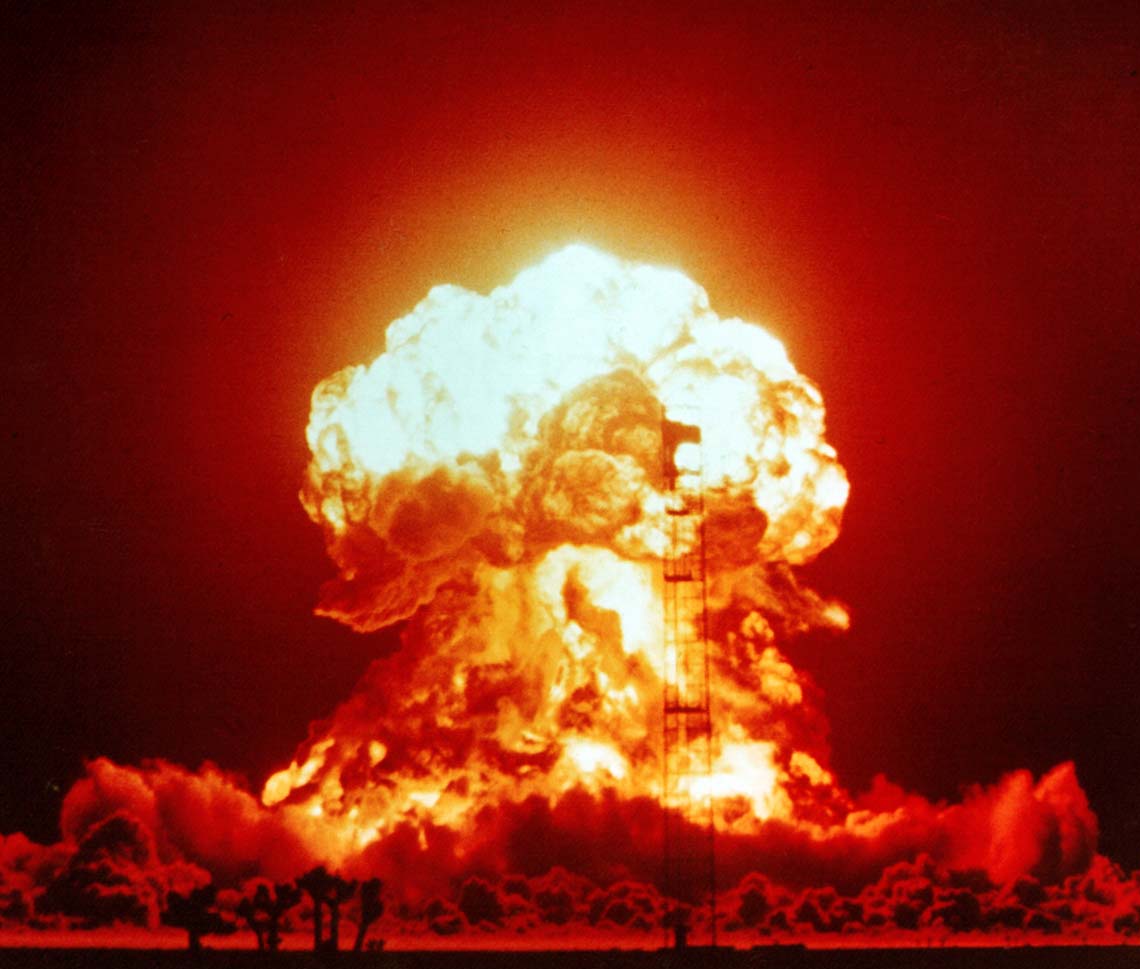So helium is a limited resource. Okay gotcha. So why not take two hydrogen atoms. Take their protons and neutrons. And just fucking start squeezing them together until you get helium?
And I don’t mean in the same way you get H2. Those are still separate from each other.
This can be done, it’s called nuclear fusion and the sun does it constantly. The practical limitation is, largely, overcoming the electrostatic force.
Basically, because the atoms are similarly charged, squeezing them together is like trying to push together the North sides of two magnets: they repel each other. It takes a massive amount of energy to squeeze them together hard enough to overcome that repulsion, fortunately the sun has enough energy to do this fairly easily. It is much more difficult for humans to do.
… I feel like you just perfectly eli5 nuclear fusion. I’m using this example next time it comes up.
I can tell you know this, I’m just tacking it on for those who don’t:
Why do the nuclei stick together at all, once you’ve pushed them together? Because the nuclear force, which is attractive instead of repulsive, is just a little bit stronger. OK, so why then doesn’t the nuclear force just pull all atoms together? Because it is short range, and only works once the nuclei are “touching.”
So does the sun just have huge amounts of helium? Where is it getting all that helium? Can we have some
It’s making it, from the tons of hydrogen it has in the fusion process. The energy and the reason stars even do this is because all of that mass that close together spontaneously does that; starts fusing.
We can’t have any, because a star will use up all the hydrogen to make helium, then start using all of the helium to make carbon and oxygen. Then start to make…
This is overly simplified and it varies from star to star (the more massive the star, the longer it churns through “making” elements into more “complex” elements) until its core is all iron, at which point fusion becomes a net negative.
From there other things can happen like novae. All throughout this life process though, that “elemental conversion” is happening faster on the outside as opposed to the core, and stellar winds do blow off heavier elements that enrich the interstellar medium.
We need a shovel that can plunge into the sun’s core if we want its helium, TL;DR.
Our sun will stop at carbon, then hang around until it either becomes a brown dwarf, or flies through enough matter to his the Chandrasekhar limit, then KABOOM!
If you are really patient, I think the sun will inevitably give us a whole bunch of helium.
But not too patient, or else it’ll make that helium into something else.
Do I look like a fucking star?
You’re my star

This comment was the most wholesome thing I saw all week. Even though it wasn’t aimed at me, I deeply appreciate it! ☺️
Because you need the concentrated gravity of the sun to do this. Otherwise the electromagnetic force between the positively charged protons will keep them from sticking together.
Good news: This actually “creates” energy because helium is slightly lighter than two hydrogens. Look at the sun, that’s how it sends us all the nice sunshine.
Bad news: You need more energy to actually push them together.
But we’re trying to get there. That’s what all the fusion reactors are supposed to do. We’ll probably get it to work in about 50 years.
Just a tiny bit of context: we are getting fusion reactors to work in fifty years since 1950.
Powered flight was fifty years away from about the ninth century onward. Until 1903. After that it was trivial.
Because of funding cuts, so yeah bring the cash back and it will probably be even before 50 years.
Is the LHC trying to do this? I know it smashes atoms together at high speeds, is this us trying to “squeeze” the atoms together like the sun does? Or is the LHC is completely unrelated to OP’s question?
Not really, but another massive international project, ITER, is trying to do this. Its timeline is measured in decades if not the better part of a century.
I’m kinda pulling this out of my ass so I’d appreciate if someone can deny/confirm this.
I believe the LHC smashes particles to destroy them, to detect particles smaller than neutrons/protons/electrons, such as quarks.
Congratulations, you’ve invented fusion.
He’s the savior of our planet!
Fun fact: pretty much all the helium we have access to comes from alpha decay of heavier atoms, such as natural uranium. An alpha radiation particle is just a “naked” and fast moving helium nucleus. (Missing the electrons.) When this happens deep in the earth, it quickly runs into something, stops moving, and picks up some electrons to make it helium, which can accumulate in certain rocks.
Because it takes a real lot of energy. Like a real lot of it. We’re currently trying to do that in a controlled form in ITER which is still getting built
In addition to everything else mentioned, in your scenario, you would also need to pull 2 neutrons from somewhere. A helium nucleus has 2 protons and 2 neutrons, but each H nucleus (generally) is just 1 proton. The 2 neutrons are critical in holding nuclei together.
You need neutrons? I got a guy, I can get you 2 neutrons here in an attosecond
Tell Jimmy Quarks I send the following message:
When you came, you said to me as follows: ‘I will give HeyThisIsntTheYMCA (when he comes) fine quality neutrons.’ You left then but you did not do what you promised me. You put neutrons which were not good before my messenger (Pete Two-Slippers) and said: ‘If you want to take them, take them; if you do not want to take them, go away!’ What do you take me for, that you treat somebody like me with such contempt?
Takes stupid amounts of energy. That’s why we get so much energy from nuclear power.
You iust described nuclear fusion. We haven’t managed to figure out how to do it in a cost effective way yet.
Controlled and cost effective way. Fusion bombs have been a thing for half a century.
Technically, we only kinda just did. We’re experimenting with it currently on a very small scale, and will be scaling it up over the next 10 to 20 years. It’s very exciting time for nuclear fusion!
will be scaling it up over the next 10 to 20 years.
Over the next 100 to 200 years. FTFY
The ITER construction site was decided roughly 20 years ago, and the construction will take another 10 years. Beside the cost (and with the economic context, government tend to cut down research spending) the machine are huge and the technology is complex. A while ago, I’ve seen an ITER project manager showing the research toward fusion, and basically it goes up to the start of the 22th century before starting mass production of commercial fusion reactors.
At the moment, both public projects and some start-up are far from a stable exo energetic plasma (both have been achieved separately) let alone the whole energy extraction. Public project have steady but low budget, at the moment there is some money for start-up (But if you ask for public money government will tell that there is no money). However, there is a significant probability that these start-up will bend early toward another technology. High temperature supra-conductors could be a game changer for medical imaging and particle therapy for example.
Sorry, but I’m not so skeptical, nor are most people. 10-20 may be optimistic, but the hard work of proving that a fusion reaction that produce a net positive output is even a possibility is done. More than one fusion reactor has been created. The next phase of experimentation is now with different methods of reactors to find one that might work at scale.
At the furthest, it may be 50 years before our first commercial fusion reactor, but other technological advances we make in those decades could - and likely will - bring that date closer. It may be 100 years before fusion reactors are being widely built, but I doubt that, too.
It’s one of those issues where even how it’s complicated is more complicated than the vast majority of people understand. We already know fusion can work, pushes up glasses and points pompusly at the sun, but we haven’t figured out how to actually get… well, plasma to behave. Plasma dynamics is *hard :( *
We’re not even sure it can be done at all at scale. It is entirely possible that there isn’t a way to keep plasma stable. There’s been some truly incredible advancements in plasma dynamics and plasma models in recent years which is great! and its the focus of nearly all fusion research right now. But we just don’t know.
(Well, unless you want to build a bomb. We can do that. Lots of that.)
Others have already mentioned that this is fusion. But the fact that any nucleus with more than two protons exists at all is interesting. E=mc^2 is a well known equation, but not many people understand it’s practical application. If you shove 2 protons and 2 neutrons together to form Helium, the resulting nucleus weighs less than it’s constituent pieces. Where’d the lost mass go? It turned into binding energy. The energy necessary to force two positively charged protons to hang out together without flying apart. And this is part of the energy input necessary to fusion things. Conversely, when we break Uranium apart we get a lot of energy. For the same reasons. Which is how current fission reactors work.
If you really find this stuff interesting do some googling related to fission, fusion, mass defect, and binding energy.
Not the really the “same reason”. Unless that reason is the in both cases, the binding energy per nucleon is increasing. So, for interested people, also look at the binding energy per nucleon curve. Fe is boring…but stable.
“Squeezing” doing a lot of heavy lifti–er, squeezing
Because of this:

Its just hard for us. Not hard at all for a sun, which makes up a far greater proportion of observable matter than what exists at ‘our’ temperature/ gravity. Even then, gasses make up an even larger proportion of observable matter.
So a counter way of asking the same question might be “Why is it so hard to not undergo nuclear fusion?” or “Why is it so hard to not be gas?”. Even further, the observable stuff is practically nothing compared to the relatively unobservable stuff. So maybe the question could be “Why is it so hard to not be dark matter/ energy?”
Just something to consider in the framing of your question Fat Tony, is that you are asking it from your perspective, and there are assumptions baked into the view you have of the universe because of your position. If you were a neutrino, or a star, or some gas in the milky way, you might consider things very differently
Atoms in a stable state are very strong and it would take incredible amounts of energy to pull them apart
The opposite is taking protons out of atoms, aka radioactive decay.














